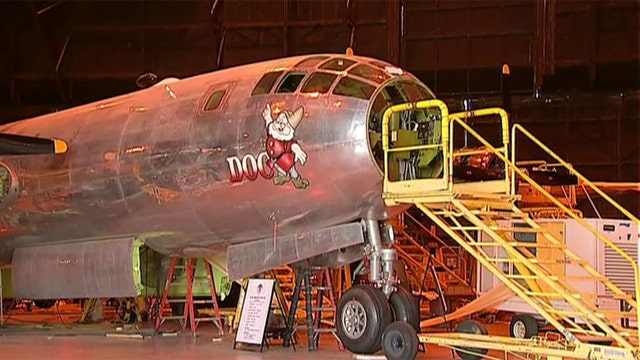WICHITA, Kan. – Decades after pieces of World War II-era history were left to deteriorate in the desert, one aircraft artifact is close to flying again.
It has been a 14-year project in the Air Capital of the World to restore a B-29 Superfortress named "Doc." It is a full-circle journey, since the historic warplane was originally manufactured in Wichita in 1944. Doc's squadron was named for Snow White and the Seven Dwarfs.
After service in the Korean War, this B-29 and others were used for target practice in the Mojave Desert.
"They towed about a hundred of them out there with Doc and they blew all of them up -- but Doc.," TJ Norman, project manager for the restoration, said. "The story is they dropped missiles or bombs six different times and missed it all six times,"
It took years of negotiations with the U.S. Navy to get it released. The non-profit organization Doc's Friends now owns it. The organization's volunteers have logged roughly 250,000 hours of painstaking work to give it new life with wires, cables, hydraulics, tubing and skins. They run on donations.
[pullquote]
When Doc takes to the skies this October or November, it will be one of only two flight-ready B-29s in the world.
"There are no more to be restored," Norman said. "We've looked all over the world. There's just no more. The desert is empty, boneyards are empty, there's no more to be had."
This also means a lack of sources for tools and parts. The team has had to fashion new ones, while staying true to the original design. Boeing, which manufactured the B-29s, did not even have the plans anymore. They had to work from drawings preserved by the Smithsonian.
"Reading the blueprints is like a second language," tooling technician Dan Wimberly said. "You have to be able to know what symbols mean and be able to do precision measuring, because everything has to fit."
Many of the people working on it are in their 70s or older. With an older group, there are safety limitations.
"I finally had to set a rule last year that if you're older than the airplane, you couldn't be up on top of the wings," Norman said.
Some have an aviation background, like Herbert Berger, who put in more than 40 years with Boeing. His work partner for the day, Bob Gerrell, says he's with the post office, but has an interest in the past.
"I restore old cars and tractors," Gerrell said. "This is my first airplane, quite an airplane to be restoring."
Many share a personal connection to the original warplane assembly effort.
"Most everybody in this hangar had relatives that worked during the war on B-29s... that's just the way it was. Everybody worked on airplanes," Norman said.
He says it matters because it is a national treasure and "you know, this airplane helped us win the war."
Once Doc takes off again, they will turn their attention to building a permanent home for the war hero. For the time being, it's housed in donated hangar space.
Fox News' Lloyd Gottschalk contributed to this report.


